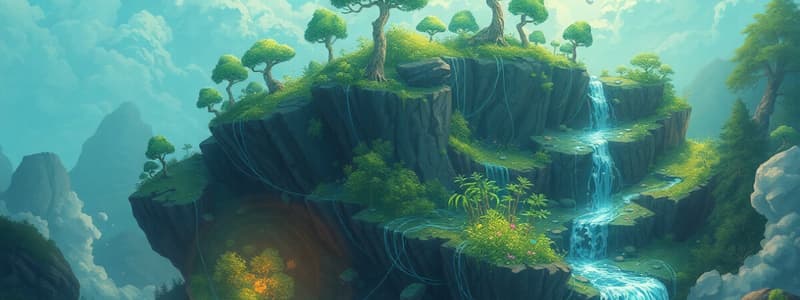Podcast
Questions and Answers
Which of the following is NOT a type of terrestrial ecosystem?
Which of the following is NOT a type of terrestrial ecosystem?
- Desert ecosystem
- Grassland ecosystem
- Pond ecosystem (correct)
- Forest ecosystem
The primary function of all ecosystems is the distribution of energy in the form of food.
The primary function of all ecosystems is the distribution of energy in the form of food.
False (B)
What are the two types of freshwater ecosystems?
What are the two types of freshwater ecosystems?
Running water ecosystems and standing water ecosystems.
Energy is transformed to chemical energy in photosynthesis by __________.
Energy is transformed to chemical energy in photosynthesis by __________.
Match the type of ecosystem with its example:
Match the type of ecosystem with its example:
According to the laws of thermodynamics, which of the following statements is true?
According to the laws of thermodynamics, which of the following statements is true?
Energy for an ecosystem comes primarily from the moon.
Energy for an ecosystem comes primarily from the moon.
What is the tertiary function of ecosystems?
What is the tertiary function of ecosystems?
What is a key difference between a food chain and a food web?
What is a key difference between a food chain and a food web?
Bio-magnification refers to the increase in concentration of non-biodegradable materials at each successive trophic level.
Bio-magnification refers to the increase in concentration of non-biodegradable materials at each successive trophic level.
What are the three types of ecological pyramids mentioned?
What are the three types of ecological pyramids mentioned?
In a grassland ecosystem, the primary consumers (herbivores) are __________.
In a grassland ecosystem, the primary consumers (herbivores) are __________.
Match the following trophic levels with their corresponding organisms:
Match the following trophic levels with their corresponding organisms:
What role do food chains and food webs play in the ecosystem?
What role do food chains and food webs play in the ecosystem?
An ecological pyramid shows the biomass that decreases as you move from the base to the apex.
An ecological pyramid shows the biomass that decreases as you move from the base to the apex.
The __________ is located at the bottom of an ecological pyramid.
The __________ is located at the bottom of an ecological pyramid.
Which of the following is categorized as a primary consumer?
Which of the following is categorized as a primary consumer?
Decomposers play a role in preventing soil erosion.
Decomposers play a role in preventing soil erosion.
What type of grassland is known for its tall grasses and scattered trees, typically found near tropical rainforests?
What type of grassland is known for its tall grasses and scattered trees, typically found near tropical rainforests?
The primary consumers depend directly on __________ for their food.
The primary consumers depend directly on __________ for their food.
Which animal is an example of a tertiary consumer?
Which animal is an example of a tertiary consumer?
Name one environmental service provided by decomposers.
Name one environmental service provided by decomposers.
Match the following types of grasslands with their characteristics:
Match the following types of grasslands with their characteristics:
Overgrazing in grasslands can lead to desertification.
Overgrazing in grasslands can lead to desertification.
Which of the following is a characteristic of grassland ecosystems?
Which of the following is a characteristic of grassland ecosystems?
Primary consumers in grasslands are carnivores.
Primary consumers in grasslands are carnivores.
What are the three types of desert ecosystems based on climatic conditions?
What are the three types of desert ecosystems based on climatic conditions?
Grasslands are important for maintaining __________.
Grasslands are important for maintaining __________.
Which component do decomposers in a grassland ecosystem primarily consist of?
Which component do decomposers in a grassland ecosystem primarily consist of?
Match the following deserts with their characteristics:
Match the following deserts with their characteristics:
The Sahara desert is an example of a tropical desert.
The Sahara desert is an example of a tropical desert.
What percentage of the world's land area do deserts occupy?
What percentage of the world's land area do deserts occupy?
Which organisms are classified as secondary consumers in a river or stream ecosystem?
Which organisms are classified as secondary consumers in a river or stream ecosystem?
Decomposers in a river or stream ecosystem include organisms like bacteria and fungi.
Decomposers in a river or stream ecosystem include organisms like bacteria and fungi.
Name one characteristic of the coastal zone in ocean ecosystems.
Name one characteristic of the coastal zone in ocean ecosystems.
The primary consumers in a river or stream ecosystem primarily feed on _______.
The primary consumers in a river or stream ecosystem primarily feed on _______.
What is a key characteristic of the abyssal zone in the ocean?
What is a key characteristic of the abyssal zone in the ocean?
Match the following components of ocean ecosystems with their descriptions:
Match the following components of ocean ecosystems with their descriptions:
Ocean ecosystems cover more than two-thirds of the Earth's surface.
Ocean ecosystems cover more than two-thirds of the Earth's surface.
What type of water is found in freshwater river or stream ecosystems?
What type of water is found in freshwater river or stream ecosystems?
Flashcards are hidden until you start studying
Study Notes
Terrestrial Ecosystems
- Terrestrial ecosystems are located on land.
- Examples include grasslands, forests, and deserts.
Aquatic Ecosystems
- Aquatic ecosystems are located in water.
- Freshwater ecosystems are further subdivided into running and standing water ecosystems.
- Running water ecosystems include rivers and streams.
- Standing water ecosystems include ponds and lakes.
- Marine ecosystems are found in the ocean and seas.
Man-Made (or) Artificial Ecosystems
- Man-made or artificial ecosystems are maintained by humans.
Function of an Ecosystem
- Ecosystems allow for the flow of energy and cycling of nutrients.
- The primary function of all ecosystems is the manufacture of starch through photosynthesis.
- The secondary function is the distribution of energy in the form of food to all consumers.
- The tertiary function involves dead organisms being decomposed to initiate nutrient cycling.
Energy Flow in Ecosystems
- Energy is essential for all living organisms.
- Solar energy is the primary source of energy for Earth.
- Solar energy is transformed into chemical energy during photosynthesis by plants.
- Some chemical energy is used by plants for growth, while the rest is transferred to consumers through eating.
Laws of Thermodynamics and Energy Flow
- First Law of Thermodynamics: Energy cannot be created or destroyed, only converted from one form to another.
- Second Law of Thermodynamics: When energy is transformed, some is lost as heat.
Food Chains and Food Webs
- Food Chains: Linear relationships showing energy flow between organisms.
- Food Webs: Interlocking network of food chains, providing more complex and diverse energy pathways.
- Significance of Food Chains and Food Webs:
- Facilitate energy flow and nutrient cycling.
- Regulate population sizes.
- Maintain ecological balance.
- Biomagnification: Non-biodegradable substances accumulate in organisms, increasing in concentration at higher trophic levels.
Ecological Pyramids
- Graphical representations of the structure and function of trophic levels, with producers at the base and consumers at the apex.
- Demonstrate the decreasing biomass and number of organisms at higher trophic levels.
- Types of Ecological Pyramids:
- Pyramid of Numbers: Shows the number of organisms at each trophic level.
- Pyramid of Energy: Represents the energy flow at each trophic level.
- Pyramid of Biomass: Shows the total biomass at each trophic level.
Grassland Ecosystems
- Cover approximately 20% of the Earth's surface.
- Characterized by grasses, with some trees and shrubs.
- Limited grazing improves net primary production, while overgrazing leads to degradation and desertification.
- Types of grasslands:
- Tropical Grasslands (Savannas): High temperatures, moderate rainfall, tall grasses, scattered shrubs and trees, animals like zebras, giraffes, and antelopes.
- Temperate Grasslands: Cold winters, hot summers, intense grazing and summer fires, limited shrubs and trees.
- Polar Grasslands (Tundra): Severe cold, strong winds, ice and snow, small annual plants in summer, animals like arctic wolves, weasels, and foxes.
Desert Ecosystems
- Occupy about 14% of Earth's land area.
- Receive less than 25 cm of rainfall.
- Characterized by dry atmosphere and poor insulation.
- Types of Desert Ecosystems:
- Tropical Deserts: Hot and extremely dry, sporadic rainfall, examples include the Sahara Desert and the Thar Desert.
- Temperate Deserts: Barren, limited rainfall, hot summers, cold winters, examples include the Atacama Desert and the Mojave Desert.
- Cold Deserts: Hot summers, extremely cold winters, found in high, flat plateaus, examples include the Gobi Desert and Ladakh.
River (or) Stream Ecosystems
- Running water is well oxygenated due to absorption from the air.
- Fewer animals compared to other ecosystems.
- Characteristics:
- Freshwater, flowing water systems.
- Mixing of water leads to higher dissolved oxygen content.
- River deposits abundant nutrients.
Saltwater Ecosystems (Ocean/Marine Ecosystems)
- Oceans cover over two-thirds of the Earth's surface.
- Characterized by high salt and mineral concentrations.
- Provide a variety of products and drugs, including iron, magnesium, and natural gas.
- Zones of Oceans:
- Coastal Zone: Shallow, warm, nutrient-rich water with high primary productivity.
- Open Sea: Deep part of the ocean, further divided into:
- Euphotic Zone: Receives abundant light, high photosynthetic activity.
- Bathyal Zone: Receives dim light, often geologically active.
- Abyssal Zone: Dark, deep zone (2000 to 6000 meters).
Studying That Suits You
Use AI to generate personalized quizzes and flashcards to suit your learning preferences.




